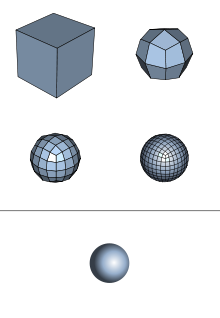Subdivision Surface
A subdivision surface (German: subdivision surface ) is in the computer graphics , a smooth (in the first or multiple derivation continuous ) surface of an output grid (also control mesh called) was produced. A subdivision surface was originally defined as the limit value (Limes) of an infinite, recursive refinement scheme. This refinement scheme is also known as the subdivision scheme ; the limit value as Limes area .
development
- 1978 Subdivision Surfaces are developed simultaneously by Edwin Catmull and Jim Clark as well as by Daniel Doo and Malcom Sabin.
- 1985 Ulrich Reif developed a method for subdivision with extraordinary vertices (German: extraordinary grid points or nodes ).
- 1990 Nira Dyn, David Levine and John A. Gregory develop the butterfly scheme.
- 1996 Dennis Zorin and Peter Schröder introduce the modified butterfly scheme.
- 1998 Tony DeRose and Michael Kass present methods for the use of Subdivision Surfaces in character animation , especially the modification of the Catmull-Clark scheme to support folds and corners of any sharpness, holes and the continuous projection of textures .
- 1998 Sederberg et al. develop the first non-uniform subdivision scheme.
- 1998 Jos Stam introduces the first non-recursive method for the calculation of Catmull-Clark Subdivision Surfaces.
Refinement Schemes

Refinement schemes can be roughly divided into two categories: interpolating and approximating. Interpolating schemes are used when the Limes surface is to interpolate the points of the output grid. Approximating schemes do not do this; the Limes area can be inside or outside the exit grid. In the case of approximating schemes, the starting grid is often the convex hull of the Limes surface. In general, most of the known approximating schemes create more aesthetically pleasing Limes surfaces.
The other distinguishing criterion, which is also used, is the categorization in schemes, which only consist of polygons with a certain number of points on grids . For example, some such schemes require an output grid made up of only triangles or squares.
Many schemas are also only defined on multiple output grids.
Approximating schemes
Approximating means that the Limes surface approximates (approximates) the output grid and the points newly generated with each recursion step are usually not on the Limes surface. Examples of approximating schemes are:
Interpolating Schemes
Interpolating means that the points of the starting grid and the points newly created by each recursion step always lie on the Limes surface. Examples of interpolating schemes are:
- Butterfly Subdivision Surfaces : The Butterfly Subdivision Surface is an interpolating subdivision scheme for triangular networks. For each iteration step, new points and edges are generated for each triangle in order to refine the network.
- Kobbelt
Web links
- Website Subdivision (English)
- Courses on the subject (English)